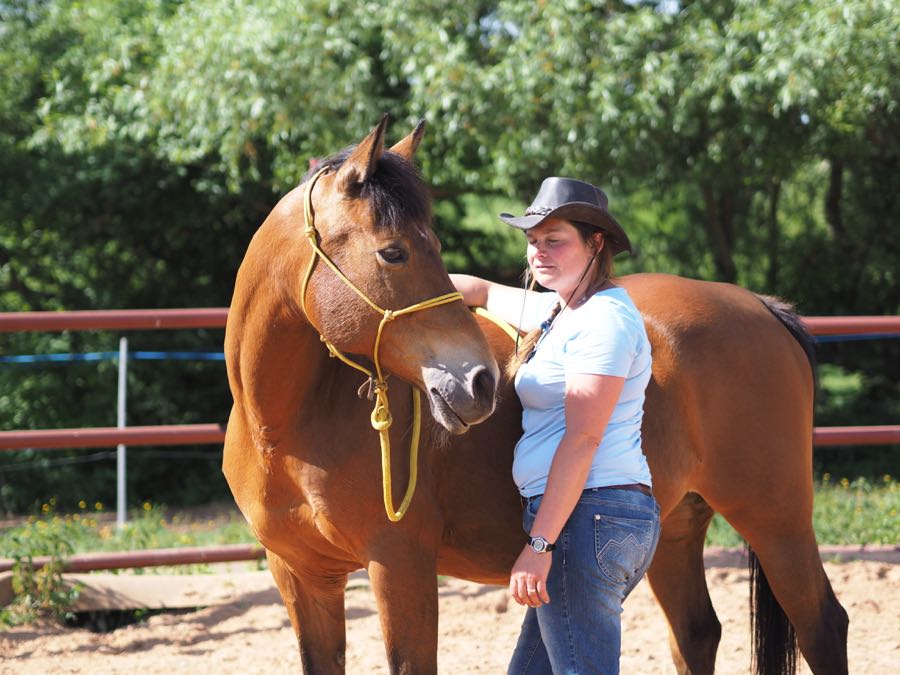Do I have to be the boss when working with the horse?
In the alternative equestrian scene there is a lot of discussion about partnership and/or dominance.
Who is the boss?
Who moves whom?
The horse must respect us as leaders. Many concepts rely on pressure and pressure amplification. If it’s a supposedly fair concept, there are stages. These sometimes end in physical pressure that lasts until the horse reacts.
In the jargon of learning psychology, this is called negative reinforcement. But since that doesn’t sound positive enough, there are other paraphrases for it. “Look, now he has confidence!” Said when displaying subordination signals.
If he doesn’t do that, maybe we’ll rush him a bit in the round pen to show our love for horses?
Misunderstood application of horsemanship
I often see horses that have learned one thing after applying horsemanship and oh so great free work: flat ears, fear of making mistakes, learned helplessness.
All tricks are unpacked to get the horses to do what we want. But they should also do it voluntarily. They should have fun and if I don’t have a rope on and the horse does it voluntarily, it must have fun! Or?
Then we are better than the conservatives, who make the horses docile with spurs and whips and, even worse, auxiliary reins and bits. Because we do horsemanship, Indian training, energy work, etc.
Buy performance with treats?
There is also another extreme. Those who buy performance. With bags of treats. Some horses become well-trained little monkeys and this robs them of their dignity. Horses are intelligent beings. They have wisdom and show us our issues. If we want to hear and see them.
The main questions:
Who am I?
How do I affect the horse?
When all tools, treats, threats and crutches are gone and only one thing remains: ME.
Who am I?
How do I appear to the horse?
Does the horse respect me?
And do I respect the horse?
Do I respect his opinion of me?
Or is it really just about manipulating the horse to do what I want. Voluntarily?
Can I look myself in the eye?
Can I look myself in the eye and say this intervention was spot on! She was helpful to develop the horse and me, to let us both grow.
A win-win situation. No, one is made small so that the other can grow. Or man makes himself small and lifts the horse onto a pedestal.
It’s about more than just the horse-human relationship. It’s about our complete system. How we are and think with our environment, with our fellow human beings, with our children, with our animals.
The collective pressure that weighs on us
Unfortunately, our social system works like this today:
Perform, adapt and you will get recognition. If you are recognized, you belong. If you don’t perform well or don’t behave appropriately, you’ll get pressure from the system. You will be excluded. If you want to survive, function like everyone else. These days we are experiencing this again in a very big way.
In contrast, we are also asked to find our individuality, because people and animals get sick. They suffer from the system. We understood that today. Distress, burnout, boaringout, psychosomatics. Stomach ulcers, eczema, behavioral disorders in the horses. That’s why everyone should do yoga or meditation, horsemanship and forest bathing. Get out of your head and into your feelings.
But only so much self-discovery, please, that we become resilient again, so that we can function again.
An example:
A horse doesn’t want to let its rider mount
Today I worked with a woman and her horse. Her horse doesn’t want to let her mount.
I watch them both. The woman hardly breathes, she is restless and tense. Blind activism.
I wouldn’t level them up either. I tell her exactly that. I tell her she has to calm down herself so that her horse no longer sees her as a burden, but as light. For that, it has to feel free with her. Without pressure, without manipulation.
Wouldn’t it help if I sat on it? I say no. This is her own journey with the horse.
First work on the ground with the horse
First we work together on the ground. There are some construction sites. Unclear signals, double messages. After some time the horse is satisfied with our work. It is relaxed and shows this through clear body language signals.
Now we go to the ascension aid. The woman practiced this for a long time. The horse immediately and well behaved to the side. But you can feel the energy rising. There is only a slight shift in weight shift away from the woman.
We just stand there and breathe. After a while, the horse will position itself comfortably and bow its head. I thank the horse for his trust. The unit is over.
A good friend of mine, Ian Benson, once said:
“Just as people work with horses, they also live their lives.”
